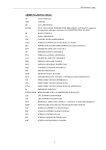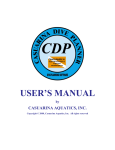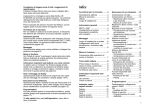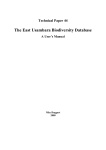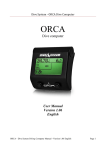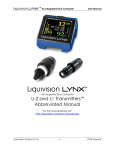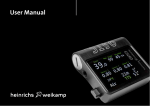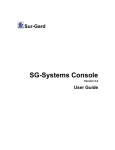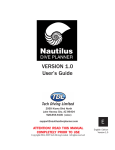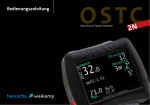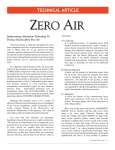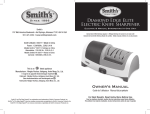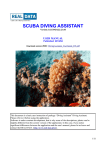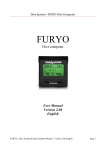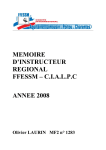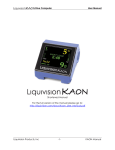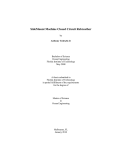Download Deco Planner Manual
Transcript
Deco Planner Manual This document is written to support version 2.0.49 17 November 2000 Copyright GUE INC The content of the this manual is not to be copied, reproduced or passed on to any third party without written permission from GUE. Deco Planner Manual Version 2.0.X Table of Contents 1 About Deco Planner ..................................................................................... 3 2 System Requirements .................................................................................. 4 3 Support......................................................................................................... 5 4 About GUE ................................................................................................... 6 5 About the Author .......................................................................................... 7 6 Credits.......................................................................................................... 8 7 Using The Program ...................................................................................... 9 7.1 The Menus............................................................................................. 9 7.1.1 The File Menu ............................................................................... 10 7.1.2 Options.......................................................................................... 12 7.1.3 Tools ............................................................................................. 14 7.1.4 Graph Analyses Tool..................................................................... 16 7.2 Preferences ......................................................................................... 18 7.3 Planning a Dive.................................................................................... 24 7.3.1 Entering basic dive information ..................................................... 24 7.3.2 Planning a dive using a travel gas for descent .............................. 30 7.3.3 Modifying gas switches / decompression times ............................ 31 7.3.4 Planning dives at Altitude.............................................................. 34 7.4 Dive Analysis ....................................................................................... 36 7.5 Dive Table Generation......................................................................... 39 7.6 Repetitive dives ................................................................................... 42 8 Decompression Theory .............................................................................. 43 8.1 Understanding M Values : Erik C Baker .............................................. 44 8.2 Deep Stops Explained : Erik C Baker .................................................. 60 9 Operational Issues and User Workarounds................................................ 69 9.1 Deep short dives with non immediate descents................................... 69 9.2 Multi level dives with immediate descent turned on ............................. 70 9.3 Narcotic properties of Oxygen ............................................................. 70 9.4 Gas Calculations when working in Imperial ......................................... 71 9.5 Surface pressure setting...................................................................... 71 10 Warnings and Errors ................................................................................ 72 11 Support Material....................................................................................... 73 11.1 Suggested Reading List..................................................................... 73 11.2 Units Of Diving................................................................................... 74 All Material is copyright to GUE 2 Deco Planner Manual Version 2.0.X 1 About Deco Plan ner Deco Planner software has been developed by a team of divers and decompression experts from around the world to model decompression for both recreational and extended range diving. The aim of the development was to produce a package which is simple to use whilst allowing more experienced divers to access to in-depth analyses of potential dive plans. Furthermore, it is intended that Deco Planner can be used as an educational tool, by providing access to divers to extensive online reference material to allow them to improve their awareness of the theory of decompression. Divers using this program should be aware that decompression is not an exact science and what this program does is attempt to draw a line through this scientific uncertainty whilst providing education such that the user can better understand the results being produced. Although this program can be used to plan extensive Nitrox and Trimix dives it is NOT intended that the program becomes a shortcut to bypass formal training in these subjects. The program Deco Planner is fully owned by its developer who retains all rights. In recognition of the input, testing, guidance and extensive help given by the others in the development team, The developer has agreed to allow Global Underwater Explorers non-exclusive rights to distribute Deco Planner exchange for a small donation to the GUE. This donation will allow GUE to continue to bring information, education and awareness to the world wide diving community and to further develop educational tools, such as this program. If you did not obtain your version of Deco Planner GUE, please contact them in order to ensure that you have the latest version and register it with them, so they can keep you informed of further developments. If you have any questions regarding operation, usage or you have some feedback about Deco Planner please contact us via one of the following routes Email General Enquiries [email protected] Registered users can email technical questions to [email protected] Telephone 1-800-762-DIVE inside the USA 904-454-0820 outside the USA 904-454-0815 (FAX) All Material is copyright to GUE 3 Deco Planner Manual Version 2.0.X 2 System Requirem ents Deco Planner has been tested on the following environments Windows 95 Windows 98 Windows 2000 Windows NT4 The following files are required for operation of Deco Planner and are installed automatically if Deco Planner is being installed from the valid setup.exe program C:\WINDOWS\SYSTEM\Msvbvm60.dll C:\WINDOWS\SYSTEM\Olepro32.dll C:\WINDOWS\SYSTEM\Oleaut32.dll C:\WINDOWS\SYSTEM\asycfilt.dll C:\WINDOWS\SYSTEM\stdole2.tlb C:\WINDOWS\SYSTEM\comcat.dll C:\WINDOWS\SYSTEM\Msvcrt.dll C:\WINDOWS\SYSTEM\Msvcrt40.dll C:\WINDOWS\SYSTEM\Mfc40.dll C:\WINDOWS\SYSTEM\Mfc42.dll C:\WINDOWS\SYSTEM\Spin32.ocx C:\WINDOWS\SYSTEM\Comdlg32.ocx C:\WINDOWS\SYSTEM\Vsocx32.ocx C:\WINDOWS\SYSTEM\spr32x30.ocx C:\WINDOWS\SYSTEM\Graph32.ocx C:\WINDOWS\SYSTEM\Gswdll32.dll C:\WINDOWS\SYSTEM\GSW32.EXE C:\WINDOWS\SYSTEM\vsvbx.lic *folder*\decoplan\decoplan.exe *folder*\decoplan\decoplan.hlp *folder*\decoplan\decoplan.cnt *folder*\decoplan\readme.txt *folder*\decoplan\install.log All Material is copyright to GUE 4 Deco Planner Manual Version 2.0.X 3 Support Deco Planner has been extensively tested during its development by a number of users under a number of system and hardware environments. However if you do encounter problems a number of options are open to you for support. All users who purchase Deco Planner from GUE are automatically registered on an email support / discussion group called [email protected]. If you are encountering an installation problem or operational problem, please provide as much detail as possible to enable the developers to assist you in resolution. Include, as a minimum, the following details in your email Description of the problem : The operating system you are using : include a copy of the install.log file (which will be found in the directory in which you installed Deco Planner). If you are struggling with operational issues or cannot find out how to complete an operation within the program, the [email protected] email list has all the worldwide users and the developers, who can provide you assistance and advice. For bug reports send an email to the [email protected] list containing the following information. Detailed description of how you can recreate the bug, include all your preferences (GFlo / GFhi, Descent options, Ascent options, Imperial / Metric settings, Model used, Ascent / Descent rates, Surface pressure etc). If possible save the dive you are working on and send the DPL file as well, (this will be found in the Deco Planner directory). If you are unable to send / receive email you can telephone/fax the following numbers. 1-800-762-DIVE inside the USA 904-454-0820 outside the USA 904-454-0815 (FAX) All Material is copyright to GUE 5 Deco Planner Manual Version 2.0.X 4 About GUE Global Underwater Explorers was created exclusively to increase the quality and diversity of aquatic education. GUE was founded by conservationists, explorers and educators with a desire to see the mystery of the underwater world explored, studied, protected and shared. Global Underwater Explorers is prepared to redefine the nature of aquatic activity in three specific areas: education, research and exploration. In sum, Global Underwater Explorers is a complete resource for the underwater enthusiast with a specific interest in seeing the underwater world explored, studied, protected and shared. By redefining the link between the underwater enthusiast and the scientific community GUE will be able initiate a unique age in underwater exploration. The evolving future of diving will allow thousands of people to combine their efforts in the pursuit of underwater recreation, education, research and exploration. The future of the underwater world is replete with unique opportunities; regardless of one's specific area of interest, Global Underwater Explorers has created a nexus to bring together the best of sport, technical and research diving in the service of environmental protection and understanding. For more information http://www.gue.com/ on All Material is copyright to GUE GUE, please visit the online website 6 at Deco Planner Manual Version 2.0.X 5 About the Autho r The author of Deco Planner is Simon Tranmer. Simon is an experienced 'C++' and VB programmer who has worked in the computer industry for 18 years Simon is an experienced diver and has been diving since 1995 in many locations around the world, including the Maldives, The Cayman Islands, Mauritius, Portugal, Cyprus and Scapa Flow. Most of his diving is on the wrecks of the UK south coast. Simon is a member of BSAC branch 1958 'Under Pressure' Simon has studied diving physiology and decompression theory as a hobby and after moving to Nitrox wanted to find a quick and easy way to plan more technical dives. After looking at the commercial programs, which were available, Simon decided to produce a program, which was easier to use and tailored to those who wanted a program based on sound principles of decompression theory. To this end he was assisted greatly by information provided by Erik Baker, an expert in decompression theory, some of whose published articles appear elsewhere in this manual. All Material is copyright to GUE 7 Deco Planner Manual Version 2.0.X 6 Credits The developers of Deco Planner would like to thank the following people for their dedication and assistance in developing the program Simon Tranmer Erik C Baker Jarrod Jablonski Andy Kerslake Graeme Davison Keith Bellamy Sue Davison & Numerous Others All Material is copyright to GUE 8 Deco Planner Manual Version 2.0.X 7 Using The Progr am 7.1 The Menus Deco Planner utilizes the concept of missions and dives. A mission is a series of dives that are started as if the diver has not completed any previous dives. Once a dive is completed, the human body is loaded with inert gas, which will off gas on the surface over a period of time. It is assumed that if >24hours are spent between dives a new mission can be started. File Menu:FILE (alt F) Access to the files menu which allows access to the following options OPTIONS (Alt O) A series of planning options which can be toggled on / off - if a tick mark is present along side the option the option is active TOOLS (alt T) Provides access to two dive planning tools GRAPH (Alt G) Provides access to a series of tissue graphs, which are used to analyse, planned dives. WINDOW (Alt W) Provides access to the standard Windows/95 window cascading, tiling facilities HELP (alt H) Contents (Alt C) Provide access to this manual Read Me (Alt R) Provides access to the revision history and any updates which did not make this manual About (Alt A) Provides access to the logon splash screen All Material is copyright to GUE 9 Deco Planner Manual Version 2.0.X 7.1.1 The File Menu File : New Mission (alt N) Start a new mission consisting of a dive series - This requires the user to have experienced at least 24 hours of surface interval from any previous dive exposure. File : Open (Alt O) Loads a previously saved mission File : Save (Alt S) Saves the current dive mission, if the mission has been previously saved, the file name is kept the same. If this is a new mission, the user is prompted for the file name. By default the mission is saved in the Deco Planner directory, this can be changed if required File : Save As (Alt A) Save the current dive mission, prompting the user for a file name, by default the mission is saved as filename.dpl in the Deco Planner directory File : Print Prints the current active window to the Windows default printer. All Material is copyright to GUE 10 Deco Planner Manual Version 2.0.X File : Printer Set up Allows the user to change basic printer options such as paper size & format as well as the default printer File : Preferences (Alt P) Gives access to a preferences screen which allows the user to set parameters used within the Deco Planner software for calculating missions & dives - See Preferences section for an explanation on the options which can be set in this section File : Exit (Alt E) Exit deco plan and return to windows All Material is copyright to GUE 11 Deco Planner Manual Version 2.0.X 7.1.2 Options Metric (alt M) If set, Deco Planner works in meters, bars and litres. If not set, Deco Planner works in feet and cubic feet (imperial), with decompression being calculated in 10 feet increments - If a dive has been planned in metric, it is possible to convert this to feet to toggling this option - the decompression will be greyed out and can be recalculated again by hitting the plan dive button Last stop at 6m (alt L) Divers decompressing on Oxygen, often prefer to complete the last stop at the optimum depth (6m/20feet) for the optimum benefit from the oxygen window. Setting this option allows Deco Planner to recalculate the last stop to be completed at 6m (20 feet) as opposed to 3m (10 foot) as with standard Bühlmann tables. Note if metric is not set this option will read "Last stop at 20 feet" Depth Safety Factor (alt S) If set all calculations are completed as if the depth is equal to (ENTERED DEPTH * 1.03) + 1 meter. This increasing of the inert gas fraction was an early attempt to introduce conservatism and comes from Bühlmann’s work. Unfortunately the problem with this method is it produces inconsistent results. Generally, short/shallow dives will result in a large margin of safety and deep/long dives will see the margin of safety decrease to inadequate levels. All Material is copyright to GUE 12 Deco Planner Manual Version 2.0.X This kind of inconsistency should not be acceptable for the calculation of mixedgas technical diving profiles. One reliable and consistent method of introducing conservatism is by controlling M-value gradients and thereby controlling Percent M-values. The Depth Safety Factor option has been included to allow users to compare Deco Planners output against other dive planning programs. Immediate descent (alt I) If set it is assumed that all the descents are immediate, if not set descent time is modelled and on gassing is accurately calculated based upon descent rates set in the preferences section. Please see operational issues for further information to be taken into account with dive planning and this parameter. Ascent in Run Time (alt A) This option causes deco stops to be calculated with the ascent time to the next stop included in the stop. This means a one minute stop is actually calculated as one minute less the ascent time to the next stop. When doing the dive this means you should plan on arriving at a stop at the start times given, NOT leaving for the next stop at the given end times. When including ascent in run times the ascent to the first stop is rounded up to the nearest minute and the extra rounding up time is considered as though it had been at depth. NOTE this is the methodology that Bühlmann originally used in his research. Table Selection (alt T) This allows access to changing which of the Algorithms is used in the Deco Planner software - currently 2 of the Bühlmann’s systems are used ZHL16B and ZHL16C. ZHL16B is intended for generation of tables and dive profiles, ZHL16C is intended for minute by minute calculations such as those computed by a in water dive computer. Both models have been included as educational tools. For most dive planning it is recommended the user uses ZHL-16B. All Material is copyright to GUE 13 Deco Planner Manual Version 2.0.X 7.1.3 Tools The tools menu gives access to a dive calculator and table generation facility Calculator (Alt C) Gives access to a depth (in feet or meters) to best mix and max operating depth calculator - by entering a depth figure in either the MSW (metric) or FSW (imperial) windows, the tool can then calculate the PP02, MOD (based on the set PP02). The tool also calculates, if the mix contains no helium, an equivalent air depth (assuming O2 is not narcotic) or if helium is present in the mix an Equivalent Narcosis depth is calculated. All Material is copyright to GUE 14 Deco Planner Manual Version 2.0.X MSW to FSW calculations can also be performed. The user can increase or decrease the depths and gas contents with the simple use of the up/down tumbler arrows to the right of the window in question. Entering a time in the CNS/OTU section will give simple CNS% and OTU calculations for the mix in question assuming all the time is spent at the same depth. Two Buttons are present for Best mix and Best Depth - these will calculate best mix based on the set PP02 and set EAD. Selecting these buttons will modify the relevant calculator entry in order to display the relevant answer Tables (Alt T) The bottom gas FO2 and FHe (in percent) are entered in the top two windows. The table start depth (i.e. the minimum planned dive depth) and the table start time (i.e. minimum planned dive time) are then entered. Maximum planned dive depth and time are then entered in the next two windows. The object of these windows is to enter the four corners of the planning variables Further information is presented in Dive Table Generation All Material is copyright to GUE 15 Deco Planner Manual Version 2.0.X 7.1.4 Graph Analyses Too l The pressure graph is a useful tool for analysing decompression profiles because a diver can see both the computed gas loadings and the M-values for a profile and easily visualize the general characteristics of the profile. This includes identifying when the profile is in the "decompression zone" (gas loadings above ambient pressure), identifying excessive gradients over ambient pressure, identifying stops that are "too deep," identifying a surge or "swell" of gas loadings over ambient pressure at a particular point, and identifying when individual inert gases are on-gassing and off-gassing. The Y-axis is the compartment inert gas pressure (absolute) and the X-axis is the ambient pressure (absolute) An M-value (maximum value) is the maximum tolerated partial pressure (absolute) of inert gas for a given compartment at a given ambient pressure. The range of M-values for a given compartment over the range of possible ambient pressures are shown as the upper straight lines, with the slope being equal to or less than 45 degrees on the diagram above The ambient pressure line (APL), the thick black line, is simply a reference line on the graph with a slope of 45 degrees and passing through the origin. The APL represents all points where the compartment inert gas pressure will be equal to ambient pressure. Points plotting above the ambient pressure line will represent overpressure (or supersaturation) in the compartment(s). All Material is copyright to GUE 16 Deco Planner Manual Version 2.0.X The graph normally shows all 16 compartments, however it can be can be used to zoom into show individual compartment data. Whilst in graph mode, the minus key will remove all compartment lines and then each compartment can be displayed by keying its relevant number on the keyboard i.e. 1 for compartment 1, 2 for compartment 2 etc. Note as we have to deal with 16 compartments we adopt the hexadecimal numbering scheme where the A key is used for compartment 10 through to F for compartment 16. The PLUS key is used to display all 16 compartments again. All Material is copyright to GUE 17 Deco Planner Manual Version 2.0.X 7.2 Preferences Settings Descent rate This parameter is only used if the option for immediate descent is set. With the immediate descent option turned on this rate in meters per min (or feet per min if not in metric) will be used to calculate run times and on gassing for the descent phases of the dive plan. Otherwise it is assumed the descent from surface to the first defined dive depth is zero seconds. Surface Pressure MB This is the known ambient surface pressure, if the actual surface pressure is not known, it is recommended that this be set to 1013mb. This parameter is limited to a setting between 300mb and 1500 mb. Gradient Factor Lo % The % gradient factor controlling the decompression at the first decompression stops, the lower the figure entered, the deeper the first decompression stops will start. For a detailed explanation of gradient factors please see Deep Stops Explained by Erik Baker Range Increments: Mins This value sets the increment period used in planning the variable time on the last dive segment entered Ascent rate All Material is copyright to GUE 18 Deco Planner Manual Version 2.0.X This is the ascent rate used in calculating dive times in meters per min (or feet per min if running Deco Planner in feet) the recommended ascent rate is 10m/min (30 feet/min) Cylinder working pressure This is the default cylinder working pressure in BARS - this value is used in both bottom gas and deco gas calculations. Note, if Deco Planner is not set to metric any value entered into this field is not used in any calculation. To calculate bars from PSI the following calculation is used BARS = PSI / 14.7 Gradient Factor Hi % The % gradient factor controlling the decompression at the last decompression stop (i.e. the surface). For a detailed explanation of gradient factors please see Deep Stops Explained by Erik Baker All Material is copyright to GUE 19 Deco Planner Manual Version 2.0.X Bottom Gas Defaults Breathing Rate L/min This is your breathing rate in litre’s per min (or cubic feet per min if running Deco Planner in feet) this is used in calculating gas requirements for the NON decompression portion of the dive. Any figure > 0 can be added, it is left to the user to ensure that a valid figure has been entered to ensure that valid gas requirement calculations are completed. Cylinder size This is the default cylinder size, in litres when working in metric or cubic feet (at cylinder rated pressure) if working in imperial. The cylinder size is used in calculating gas requirements for back gas mix. Reserve (bar) This is the reserve gas, which is not taken into account in the gas requirement calculation. It is good practice to always ensure adequate gas is available, and a reserve should always be used. A minimum figure of a third, of the initial gas, should be reserved for any dive in an overhead environment including a decompression dive. To calculate bars from PSI the following calculation is used BARS = PSI / 14.7 O2 Percentage This is the default Nitrox mix used for all bottom gas calculations, It is left to the user to ensure that PO2 levels are not exceeded when planning a dive. This can be changed within the Deco Planner page whilst entering details. Deco Planner All Material is copyright to GUE 20 Deco Planner Manual Version 2.0.X warns the user of excessive PO2’s in the dive display by displaying PO2’s greater than 1.4 in orange and PO2’s greater then 1.6 in red. All Material is copyright to GUE 21 Deco Planner Manual Version 2.0.X Deco Gas Defaults Breathing Rate This is your breathing rate in Litres per min (or cubic feet per min if running Deco Planner in feet) at resting and is used in calculating gas requirements for the decompression portion of the dive. Any figure > 0 can be added, it is left to the user to ensure that a valid figure has been entered to ensure that valid gas requirement calculations are completed. Cylinder size This is the default cylinder size, in litters when working in metric or cubic feet (at cylinder rated pressure) if working in imperial. The cylinder size is used in calculating gas requirements for all decompression gas mixes. The cylinder sizes can be changed on the main dive planning screen. Reserve (bar) This is the reserve gas, which is not taken into account in the gas requirement calculation. It is good practice to always ensure adequate gas is available, and a reserve should always be used To calculate bars from PSI the following calculation is used BARS = PSI / 14.7 O2 Percentage This is the default Nitrox mix used for the last decompression gas of a dive; it is left to the user to ensure that PO2 levels are not exceeded when planning a dive. This can be changed within the Deco Planner page whilst entering details. Deco All Material is copyright to GUE 22 Deco Planner Manual Version 2.0.X Planner warns the user of excessive PO2’s in the dive display by displaying PO2’s greater than 1.4 in orange and PO2’s greater then 1.6 in red. All Material is copyright to GUE 23 Deco Planner Manual Version 2.0.X 7.3 Planning a Dive 7.3.1 Entering basic dive i nformation Note : Planning dives with Deco Planner set to work in feet, follows exactly the same process as detailed below. In order to keep files sizes to a minimum only metric pictures have been included. Dive planning in Deco Planner is very simple; the cursor is positioned in the depth plan section, in the depth column using the mouse. The depth of the first portion of the dive is entered. The right cursor key is used to move across to the time column where the time at that depth is added. The %O2 and %He (% He is only added if using Trimix/Heliox) content of the mix can now be entered by moving to these columns with the right arrow key (the remainder to 100% is assumed to be nitrogen). In the example a bottom mix of EAN30 has appeared as this is the default bottom mix, which has been set in the dive preferences All Material is copyright to GUE 24 Deco Planner Manual Version 2.0.X If EAN30 was not being used for this dive, the user can edit both the %O2 and the %He at this point. It can be seen that Deco Planner has calculated that completing this dive, to 36m for 30 mins, has already produced a ceiling of 15m for decompression (shown in the blue circle). Deco Planner can now be instructed to calculate the decompression schedule or additional dive segments can be added to the dive profile. In order to plan a multi level dive, the user moves down a row in the depth plan section and enters other depth/times. In the example shown, we have planned a second segment in the dive of 30 minutes at 22 meters. We now see that completing this second segment has allowed some off gassing and the decompression ceiling has risen to 9 m. Additional segments can be added to the dive profile up to a MAXIMUM of 20 depth segments. The user simply utilizes the cursor arrow keys to navigate around the depth plan section. Whilst entering the dive segments it is possible to delete individual depth/time segments by hitting CTRL+D when the cursor is on the line to be deleted. If more than 4 segments are entered in a dive plan, the user can either use the scroll bar (to the right of the Depth plan window) to scroll up and down for review and edit or may resize the window, by placing the mouse on the bottom of the depth plan window, click and hold the mouse button and then drag the window down to make it bigger. All Material is copyright to GUE 25 Deco Planner Manual Version 2.0.X If the user wishes to delete all the dive depth and time segments entered, they can simply click on the clear button which is above the depth plan window Note : After entering depth and breathing gas information, it is possible to have Deco Planner calculate the no decompression time limit for a dive to that depth by keying a ? whilst the cursor is in the time cell (if a figure of zero is returned, the dive is a decompression dive) Entering Deco gas information Once the dive segments have been entered the user either TABS across to the deco gas window or clicks with the mouse in the window to enter the chosen decompression mixes. In the deco gas window, the user can enter the decompression mix, which is to be used from each depth. To the right of the depth window is a menu pull down which allows gas switch points to be chosen down to a maximum depth of 90m. To access this menu the user simple left click with the cursor and then uses the scroll bar to enter the gas switch depth. In the example shown we have chosen to complete all decompression at <=6m on 100% O2. Multiple decompression mixes can be used upto a maximum of 20 different mixes. Note no checking is undertaken regarding max PO2 decompression gases and it is possible to call up 100 % O2 for 60m - which is NOT recommended. As with the depth plan, it is possible to delete individual lines within the Deco gas window by hitting CTRL+D when the cursor is on the line to be deleted If the user wishes to delete all the decompression gases used, they can simply click on the clear button which is above the deco gas window Gas Plan All Material is copyright to GUE 26 Deco Planner Manual Version 2.0.X The only columns that can be changed are the Size & Reserve columns. When working in metric, the BAR column indicates how many bar is needed (inc. the reserve) to complete the dive. If this figure is in RED it is exceeding the maximum cylinder pressure set in the preferences, increase the cylinder size used for the dive - note it is good practice to always ensure adequate gas is available, and a reserve should always be used. NOTE full gas plan information is only available once the dives has been planned When working in Imperial, the user can change the cylinder size presented in the gas plan window, the figure given in the cubic feet column is the free gas required to complete the dive including the reserve. If the user wishes to delete the contents of the gas plan window, they can simply click on the clear button which is above the gas plan window PLAN DIVE BUTTON This button calculates the dive decompression and gas requirements. All relevant decompression mixes programmed into Deco Planner are used in the dive plan. In the above diagram, the decompression requirement for this dive is shown. The details show that a 1 minute stop at 9m and 6 min stop (on Oxygen) is required. In addition the pressure in the 24l cylinders is shown in red, this is because the calculated fill pressure needed to complete the dive, exceeds the cylinder working pressure set in the preferences. All Material is copyright to GUE 27 Deco Planner Manual Version 2.0.X NO DECO GAS BUTTON This button calculates the dive decompression and gas requirements assuming ALL decompression mixes have been lost and the dive is to be conducted only on the Depth Plan information As can be seen in the above example the previous calculated 6 min at 6m stop has been increased to 14 mins. THE DIVEPLAN WINDOW The Deco Planner window gives detailed information of the depth plan entered (above the first dark black line) and decompression calculated. Full run time information giving starting and ending times for all the stops is included. The display also shows CNS % and OTU's, which are cumulative as the dive progresses (as such the %CNS and OTU’s for the end of the dive are shown in the last row). The Mval% display shows the maximum M value during the dive, this figure will rise as the diver ascends and arrives at the next depth in the dive plan (including the decompression stops). Between the bottom two black lines a summary of some important surfacing details are shown : namely , the surfacing run time (red circle), the MAXIMUM surfacing Gradient Factor (green circle) and MAXIMUM surfacing M Value (blue circle). If the diver decides that the surfacing M value is too great, the Gradient factor low (GF Lo%) and Gradient factor high valves (GF Hi%) can be modified, as shown, to change the conservatism used for the dive plan. All Material is copyright to GUE 28 Deco Planner Manual Version 2.0.X For details on how to use Gradient factors to control dive conservatism please read the section on dive analysis If any details in the depth plan window are changed, the details in the Deco Planner window are greyed out to show they are now longer valid, hit either the Plan Dive or the No Deco Gas buttons to replan the decompression obligation again. RANGE PLAN BUTTON Gives access to a simple dive range planning tool, This tool will calculate the decompression obligation (using all the defined gases) whilst varying the last dive segment time from zero to the entered time in the time interval which was set in the Dive preferences. If only one dive segment has been entered and the user is using Deco Planner to calculate a set of dive tables, Deco Planner offers a much more feature rich facility in the table generation option. GRAPHS Gives access to a series of in-depth dive analysis graphs ANALYZE Provides access to a detailed dive analysis tool NEXT DIVE This allows the planning of repetitive dives. All Material is copyright to GUE 29 Deco Planner Manual Version 2.0.X 7.3.2 Planning a dive usin g a travel gas for descent When planning a dive with non immediate descent set, Deco Planner makes some assumptions on which gas is used whilst modelling each separate descent. The first descent (i.e. from the surface) is always completed on the gas entered for the first dive segment. The next descent to the next depth / time segment is completed on the same gas UNLESS the PO2 would exceed 1.6 in which case the descent is completed on the gas entered for the next depth / time segment. This logic attempts to differentiate from a dive where the diver is descending on a travel gas and a dive where the early part of the dive is a multi level profile followed by a travel gas switch. For instance a Diver is planning a dive to 85 m on bottom mix of 14/55. As this mix is Hypoxic at the surface the diver intends to drop to 18m on his first deco mix (EAN50). The diagram below shows the details entered into Deco Planner and the subsequent analysis chart showing the gases used in modelling the descent. The diver has assumed a 1 min pause at 18m for the gas switch (by entering a time of 2 minutes, the dive has modelled approx one minute for descent and 1 minutes for gas switch). Looking to the analysis on the right, the gas used in the computation are shown (highlighted in green). Segment one (initial descent) is completed on EAN50. The diver holds at 18m for one minute (actually 1.1 minutes) completing the gas switch and then descends on the Trimix 14/55 from 18m to 85m If the Diver had planned this dive dropping on EAN 50 to a depth at which the PO2 is greater than 1.6, Deco Planner will indicate the PO2 in red and immediately gas switch to the next gas for the next descent. All Material is copyright to GUE 30 Deco Planner Manual Version 2.0.X 7.3.3 Modifying gas switc hes / decompression times In the following example a user has planned a dive of 30 minutes to a depth of 55m, decompressing with EAN50 from 21m and Oxygen from 6m. Research has shown that it is advantageous to extend a gas switch decompression stop (to around 5 minutes) to gain benefit from the Oxygen window and to account for the delay in transport of oxygen around the body by the blood system. The user in this example has therefore elected to extend the 21m stop on EAN50 to 5 minutes. This is simply done by entering this information into Deco Planner, as normal. A warning is generated, informing the user that this dive segment is shallower than the calculated ceiling and decompression stops will be added. All Material is copyright to GUE 31 Deco Planner Manual Version 2.0.X Upon accepting this warning, the 21m segment is shown in red on the dive plan window and when decompression is calculated, Deco Planner will calculate the decompression stops as before, extending the 21m time to 5 minutes. As can be seen in the diagram below, the stops shallower than 21m have been modified to account for the benefit gained at 21m If the user attempts to modify a stop time with a time shorter than the required time, Deco Planner will account for this as shown below. A user has selected a 21m stop of 5 minutes, however the profile in question required a 21m stop in excess of this, as such Deco Planner automatically ensure the extra time is calculated and shown. All Material is copyright to GUE 32 Deco Planner Manual Version 2.0.X This facility can also be very useful in cave diving where the cave profile may lengthen sections of the decompression forcing longer stops than planned. In the following example a dive is being planned in which a section of cave, at 24m, is part of the cave exit. This depth is in our decompression zone, and the user know that it will take us 10 minutes to traverse this cave section. The user enters details as before, including the 10 minutes at 24m that they will be forced to undertake. In addition the user wishes to extend the21m stop on EAN50 (as before), so this is also entered. Deco Planner takes these modifications to the previously calculated decompression into account and recalculates the decompression whilst still taking into account the user Gflo / GfHi settings. All Material is copyright to GUE 33 Deco Planner Manual Version 2.0.X 7.3.4 Planning dives at Al titude Deco Planner can be used to plan dives at altitude by using the surface pressure parameter in the Dive Plan Preferences. This parameter takes into account, altitude as well as the ambient surface pressure due to the current weather system. The correct option is to take a calibrated barometer to the dive site, which will actually measure the ambient pressure and thus take both weather and altitude into account. If this is not possible and the altitude and sea level ambient pressure is known, the pressure at altitude can be calculated from the following equation. p(z) = po * exp(-Mgz/RT) Where po = 1013.25 mbar M = 28.8 g/mol = 0.0288 Kg/mol g = 9.81 m/s^2 R = 8.314 S.I. T = temperature in Kelvin’s (to convert degrees Celsius to Kelvin’s add 273) All Material is copyright to GUE 34 Deco Planner Manual Version 2.0.X This formula can be simplified as follows (assuming the temperature is 15C) p(z) = 1013.25 * exp(-z/8475) Don't forget that 'z' must be in meters (not in feet or kilometres). The following tables assumes sea water surface pressure = 1013.25 and temperature at altitude is 15 C Altitude (m) Pressure (mb) 500 955 1000 900 1500 849 2000 800 All Material is copyright to GUE 35 Deco Planner Manual Version 2.0.X 7.4 Dive Analysis The Deco Planner Analysis Display provides detailed information about tissue pressures in all compartments for each segment of the dive. Dive Segments For analysis purposes any dive is broken down into segments. Each segment is either a constant depth segment or a continuous ascent/descent segment. For example a dive to 30m / 100ft might consist of 5 segments as follows; A descent segment (assuming immediate descent is switched off) A constant depth segment for the bottom time at 30m / 100ft An ascent segment from the bottom to the 6m / 10ft stop A constant depth segment for the deco stop An ascent segment for the ascent from the deco stop to the surface Ascent or Descent segment Information The first two columns of the Analysis chart (as shown in the red rectangle) give information about the segments as follows; SEG:1 START DEPTH FINAL DEPTH RATE SEG TIME RUN TIME MIX 02 MIX He The segment number. Segments count from 1 upward. The segment is either ASC or DESC for an ascent or descent segment The starting depth for the ascent or descent The final depth for the ascent or descent The ascent or descent rate used for this segment (These rates are set from the preferences option on the File menu) The duration of this segment in minutes The total accumulated dive time at the end of the segment The percentage of Oxygen in the breathing gas during this segment The percentage of Helium in the breathing gas during this segment All Material is copyright to GUE 36 Deco Planner Manual Version 2.0.X Constant Depth or Decompression stop segment Information SEG:2 CONST DEPTH PO2 ATA SEG TIME RUN TIME MIX 02 MIX He The segment number. The segment is shown as a STOP segment The constant depth for this segment The partial pressure of Oxygen at this depth (in ATA) The duration of this segment in minutes The total accumulated dive time at the end of the segment The percentage of Oxygen in the breathing gas during this segment The percentage of Helium in the breathing gas during this segment Compartment Information The remaining columns of the analysis show information for each of the 16 theoretical tissue compartments. The column headings are from ‘Cpt 1’, (the fastest tissue, shown in the red rectangle above) to ‘Cpt 16’, (the slowest tissue). Each segment has 9 rows of data for each compartment as follows; PHe PN2 PHe+PN2 %Ambient The pressure of Helium in the compartment measured in MSW (Meters of sea water) or FSW (Feet of sea water) The pressure of Nitrogen in the compartment measured in MSW (Meters of sea water) or FSW (Feet of sea water) The sum of the pressures of Helium and Nitrogen in the compartment as given in the previous two rows The percentage of the inert gas pressures in the compartment, as compared to the ambient pressure. All Material is copyright to GUE 37 Deco Planner Manual Version 2.0.X He Grad N2 Grad M-Value %M-Value %M-V Grad The Helium gradient shows the difference in pressure between the current compartment helium pressure and the fully saturated compartment helium pressure. Once the tissue is fully saturated this value will show zero. A positive value means the compartment has a gradient driving the gas into it. In other words the compartment is on-gassing. A negative value means the compartment has a gradient driving the gas out of it. In other words the compartment is off-gassing The Nitrogen gradient shows the difference in pressure between the current compartment nitrogen pressure and the fully saturated compartment nitrogen pressure. As with the H2 Gradient; Once the tissue is fully saturated this value will show zero. A positive value means the compartment has a gradient driving the gas into it. In other words the compartment is on-gassing. A negative value means the compartment has a gradient driving the gas out of it. In other words the compartment is off-gassing The M-Value shows the maximum allowed compartment pressure. This value is a combined value for N2 and He. To see how close to the M-Value a compartment is, compare this value to the PHe+PN2 row This value shows the percentage of the M value reached by the compartment. This value is calculated by comparing the PHe+PN2 value to the M-Value. It is a measure of how close to the M-Value the inert gas pressure is. A value of 100 would mean that the compartment pressure has reached it’s maximum possible theoretical tolerance This value shows how far into the decompression zone the compartment is. The percentage is a measure of the compartment insert gas pressure as compared with the difference between the M-Value and the ambient pressure. A negative value here means that the compartment pressure is below ambient and is therefore still on-gassing. A positive value here means that the compartment pressure is above ambient (in the decompression zone) and is therefore offgassing. A value of 100 would mean that the compartment pressure has reached it’s maximum possible theoretical tolerance The values in each of the compartments are compared to determine the highest value and this value is shown in blue. This allows you to see immediately the leading tissue compartment for each segment. All Material is copyright to GUE 38 Deco Planner Manual Version 2.0.X 7.5 Dive Table Generat ion Note : Dive table generation with Deco Planner set to work in feet, follows exactly the same process as detailed below. In order to keep files sizes to a minimum only metric pictures have been included. The diagram below shows the table set up for a dive. In the example we are planning a wreck dive where the depth is unknown, but is thought to be between 30 and 40m. The planned dive is 40 minutes however we may call the dive after 15 minutes and if its real good we may stay for 60 mins The next entry is the depth increments that are to be planned i.e. in the example shown above, Deco Planner will calculate a table every 3 m between table start depth and table end depth The last entry is the time increments that are to be planned i.e. in the example shown, Deco Planner will calculate a table every 5mins between table start time and table end time To reduce the number of tables calculated the option of "only show one time with no deco" can be set - if the depth/time tables being calculated will result in a lot of no decompression dives , Deco Planner will only show the No decompression limits and not output any dive that is less than this. As well as choosing the dive bottom mix (in the example a 28% EAN mix is used), the user can choose to use multiple decompression mixes, the diagram above, shows that all decompression less than and equal to 6m is to be completed on 100 % Oxygen (in blue). All Material is copyright to GUE 39 Deco Planner Manual Version 2.0.X Upon hitting the OK button Deco Planner will start calculating the dive tables requested. In the diagram above it is seen that some of the information is in a red box with <>signs around the number. This is to indicate that the user does not have enough gas to complete the dive based upon cylinder size, reserves and breathing parameter settings set in the user preferences section. All Material is copyright to GUE 40 Deco Planner Manual Version 2.0.X The dive table contains a lot of additional information to assist in dive planning. In the following diagram, sections have been highlighted to assist in the description of the output The pink section details the preferences set in calculating the dive table (i.e. which model used gradient factors etc) The yellow section indicates which gas is being breathed at which depth The green section shows the total DECOMPRESSION time for each dive time The diagram above shows the same dive planned, however this time the user selected the option in the table generator window to display oxygen information as well shown in blue. All Material is copyright to GUE 41 Deco Planner Manual Version 2.0.X 7.6 Repetitive dives Deco Planner allows the user to plan repetitive dives over any period. The theory behind repetitive dives is based on Bühlmann’s pulmonary shunt model. During a surface interval, the elimination of gas is delayed due to the pulmonary shunt mechanism and the gas loading remain higher than a normal set of calculations would conventionally calculate. Accordingly, on repetitive profiles, it will mean either less no-stop time or longer deco time. Deco Planner runs gas loading calculations for all the compartments on a CONTINUOUS basis which may cover days or even weeks! The gas loading are calculated and updated within a MISSION and are calculated dependent on what the diver is doing (surface interval or diving) At the end of the first dive of a mission (i.e. after all decompression) each compartment will have a certain loading of helium and nitrogen. Generally, after oxygen decompression, the fast compartments will be completely empty of helium and nitrogen and they will ON-GAS with nitrogen during the surface interval! The slowest compartment, 635 min for nitrogen, takes over 2-1/2 days to completely off-gas so any repetitive dive will halt that process. Until a better implementation of the pulmonary shunt model is developed, Deco Planner behaves as if the surface interval is at one meter breathing 21 % (i.e. Air) as such the tissues never clear completely, as such once a surface interval of 3-4 hours is exceeded the penalty on the subsequent dive is the same whether the diver waits 4 or 24 hours All Material is copyright to GUE 42 Deco Planner Manual Version 2.0.X 8 Decompression Theory We are please to be able to reproduce a number of articles from experts around the globe as part of this manual. This software package would not have been possible, without these articles and the guidance provided by their authors. Erik C. Baker is an electrical engineer with an architecture/engineering firm in Pennsylvania. He pursues research into decompression and diving physiology as a hobby, and has developed several FORTRAN computer programs for decompression calculation and analysis. Erik is a certified cave diver and trimix diver. Understanding M Values : Erik C Baker Deep Stops Explained : Erik C Baker All Material is copyright to GUE 43 Deco Planner Manual Version 2.0.X 8.1 Understanding M V alues : Erik C Baker In conjunction with an array of hypothetical "tissue" compartments, gas loading calculations and M-values compose the major elements of the dissolved gas or "Haldanian" decompression model. Through the use of widely-available desktop computer programs, technical divers rely on this model for their decompression safety. A good understanding of M-values can help divers to determine appropriate conservatism factors and evaluate the adequacy of various decompression profiles for a particular dive. What are M-values? The term "M-value" was coined by Robert D. Workman in the mid-1960's when he was doing decompression research for the U.S. Navy Experimental Diving Unit (NEDU). Workman was a medical doctor with the rank of Captain in the Medical Corps of the U.S. Navy. The "M" in M-value stands for "Maximum." For a given ambient pressure, an Mvalue is defined as the maximum value of inert gas pressure (absolute) that a hypothetical "tissue" compartment can "tolerate" without presenting overt symptoms of decompression sickness (DCS). M-values are representative limits for the tolerated gradient between inert gas pressure and ambient pressure in each compartment. Other terms used for M-values are "limits for tolerated overpressure," "critical tensions," and "supersaturation limits." The term M- value is commonly used by decompression modelers. HISTORICAL BACKGROUND In the dissolved gas or "Haldanian" decompression model, gas loading calculations for each hypothetical "tissue" compartment are compared against "ascent limiting criteria" to determine the safe profile for ascent. In the early years of the model, including the method developed by John S. Haldane in 1908, the ascent limiting criteria was in the form of "supersaturation ratios." For example, Haldane found that a diver whose "tissues" were saturated by breathing air at a depth of 33 fsw could ascend directly to the surface (sea level) without experiencing symptoms of DCS. Because the ambient pressure at 33 fsw depth is twice that at sea level, Haldane concluded that a ratio of 2:1 for tolerated overpressure above ambient could be used as the ascent limiting criteria. This approximate ratio was used by Haldane to develop the first decompression tables. In later years, and up until the 1960's, other ratios were used by various modelers for the different half-time compartments. Most of the U.S. Navy decompression tables were calculated using this supersaturation ratio method. However, there was a problem. Many of the tables produced by this method were deficient when it came to deeper and longer dives. Robert Workman began a systematic review of the decompression model including previous research that had been performed by the U.S. Navy. He arrived at some important conclusions. First of all, he recognized that Haldane's original ratio of 2:1 (based All Material is copyright to GUE 44 Deco Planner Manual Version 2.0.X on air) was really a ratio of 1.58:1 if you considered only the partial pressure of the inert gas in air nitrogen. [By that time in decompression research it was known that oxygen was not a significant factor in DCS; it was the inert gases like nitrogen and helium that were the culprits.] In his review of the research data, Workman found that the "tissue ratios" for tolerated overpressure varied by halftime compartment and by depth. The data showed that the faster half-time compartments tolerated a greater overpressure ratio than the slower compartments, and that for all compartments the tolerated ratios became less with increasing depth. Then, instead of using ratios, Workman described the maximum tolerated partial pressure of nitrogen and helium for each compartment at each depth as the "M-value." Next, he made a "linear projection" of these Mvalues as a function of depth and found that it was a reasonably close match to the actual data. He made the observation that "a linear projection of M-values is useful for computer programming as well." THE WORKMAN M-VALUES Workman's presentation of M-values in the form of a linear equation was a significant step in the evolution of the dissolved gas decompression model. His M-values established the concept of a linear relationship between depth pressure [or ambient pressure] and the tolerated inert gas pressure in each "tissue" compartment. This concept is an important element of the present-day dissolved gas model as applied by a variety of modelers. Workman expressed his M-values in the slope-intercept form of a linear equation (see Figure 1). His surfacing value was designated Mo [pronounced "M naught"]. This was the intercept value in the linear equation at zero depth pressure (gauge) at sea level. The slope in the linear equation was designated M [pronounced "delta M"] and represented the change in M-value with change in depth pressure. THE BUHLMANN M-VALUES Professor Albert A. Bühlmann, M.D., began doing decompression research in 1959 in the Laboratory of Hyperbaric Physiology at the University Hospital in Zurich, Switzerland. Bühlmann continued his research for over thirty years and made a number of important contributions to decompression science. In 1983 he published the first edition (in German) of a successful book entitled Decompression Decompression Sickness. An English translation of the book was published in 1984. Bühlmann's book was the first nearly complete reference on making decompression calculations that was widely-available to the diving public. As a result, the "Bühlmann algorithm" became the basis for most of the world's in-water decompression computers and do-it-yourself desktop computer programs. Three more editions of the book were published in German in 1990, 1993, and 1995 under the name Tauchmedizin or "Diving Medicine." [An English translation of the 4th Edition of the book (1995) is in preparation for publication]. All Material is copyright to GUE 45 Deco Planner Manual Version 2.0.X Bühlmann’s method for decompression calculations was similar to the one that Workman had prescribed. This included M-values which expressed a linear relationship between ambient pressure and tolerated inert gas pressure in the hypothetical "tissue" compartments. The major difference between the two approaches was that Workman's M-values were based on depth pressure (i.e. diving from sea level) and Bühlmann’s M-values were based on absolute pressure (i.e. for diving at altitude). This makes sense, of course, since Workman was concerned with the diving activities of the U.S. Navy (presumably performed at sea level) while Bühlmann was concerned with diving activities in the high mountain lakes of Switzerland. Bühlmann published two sets of M-values which have become well-known in diving circles; the ZH-L12 set from the 1983 book, and the ZH-L16 set(s) from the 1990 book (and later editions). The "ZH" in these designations stands for "Zurich" (named after his hometown), the "L" stands for "limits," and the "12" or "16" represents the number of pairs of coefficients (M-values) for the array of half-time compartments for helium and nitrogen. The ZH-L12 set has twelve pairs of coefficients for sixteen half-time compartments and these M-values were determined empirically (i.e. with actual decompression trials). The ZH-L16A set has sixteen pairs of coefficients for sixteen half-time compartments and these Mvalues were mathematically-derived from the half-times based on the tolerated surplus volumes and solubilities of the inert gases. The ZH-L16A set of M-values for nitrogen is further divided into subsets B and C because the mathematicallyderived set A was found empirically not to be conservative enough in the middle compartments. The modified set B (slightly more conservative) is suggested for table calculations and the modified set C (somewhat more conservative) is suggested for use with in water decompression computers which calculate in real-time. Similar to the Workman M-values, the Bühlmann M-values are expressed in the slope-intercept form of a linear equation (see Figure 1). The Coefficient a is the intercept at zero ambient pressure (absolute) and the Coefficient b is the reciprocal of the slope. [Note: the Coefficient a does not imply that humans can withstand zero absolute pressure! This is simply a mathematical requirement for the equation. The lower limit for ambient pressure in the application of the Bühlmann M-values is on the order of 0.5 atm/bar.] All Material is copyright to GUE 46 Deco Planner Manual Version 2.0.X All Material is copyright to GUE 47 Deco Planner Manual Version 2.0.X All Material is copyright to GUE 48 Deco Planner Manual Version 2.0.X DCAP AND DSAT M-VALUES Many technical divers will recognize the 11F6 set of M-values used by Hamilton Research's Decompression Computation and Analysis Program (DCAP). This set or "matrix" of M-values was determined by Dr. Bill Hamilton and colleagues during development of new air decompression tables for the Swedish Navy. In addition to air diving, the 11F6 M-values have worked well for trimix diving and are the basis for many custom decompression tables in use by technical divers. Many sport divers are familiar with the Recreational Dive Planner (RDP) distributed by the Professional Association of Diving Instructors (PADI). The Mvalues used for the RDP were developed and tested by Dr. Raymond E. Rogers, Dr. Michael R. Powell, and colleagues with Diving Science and Technology Corp. (DSAT), a corporate affiliate of PADI. The DSAT M-values were empirically verified with extensive in-water diver testing and Doppler monitoring. COMPARISON OF M-VALUES Tables 1 thru 4 present a comparison of M-values for nitrogen and helium between the various Haldanian decompression algorithms discussed in this article. All M-values are presented in Workman-style format. An evolution or refinement in the M-values is evident from Workman (1965) to Bühlmann (1990). All Material is copyright to GUE 49 Deco Planner Manual Version 2.0.X All Material is copyright to GUE 50 Deco Planner Manual Version 2.0.X The general trend has been to become slightly more conservative. This trend reflects a more intensive validation process (empirical testing) and includes the use of Doppler ultrasound monitoring for the presence and quantity of "silent bubbles" (bubbles which are detectable in the circulation but are not associated with overt symptoms of decompression sickness). CONSISTENCY OF M-VALUES One observation that can be made about the comparison between the M-values of the various algorithms is that there is not a great difference between them. In other words, there appears to be a certain consistency between the values determined by various independent researchers around the globe. This is a good All Material is copyright to GUE 51 Deco Planner Manual Version 2.0.X sign as it indicates that the science has determined a relatively consistent threshold for symptoms of decompression sickness across the human population. FORMAT FOR M-VALUES M-values are often expressed in the form of a linear equation as in the Workmanstyle or the Style-style. This format is ideal for computer programming since it allows the M-values to be calculated "on-the-fly" as they are needed. The linear format permits the display of M-value lines on the pressure graph as well. M-values can also be expressed in the form of a matrix or table. This is simply where the M-values for each half-time compartment and each stop depth are precalculated and arranged in columns and rows. This format is useful for detailed comparisons and analysis. Some of the early dive computers and desktop computer programs used the table format to "look up" M-values for each stop during the calculation process. M-VALUE CHARACTERISTICS M-value sets can be classified into two categories, no-decompression sets and decompression sets. No-decompression M-values are surfacing values only. The DSAT RDP M-values are an example. No-stop dive profiles are designed so that the calculated gas loadings in the compartments do not exceed the surfacing M- values. This allows for direct ascent to the surface at any time during the dive. Some no-decompression algorithms account for ascent and descent rates in the calculations. Decompression M-values are characterized by having a slope parameter which determines the change in M-value with change in ambient pressure. The value of the slope parameter will vary depending on the half-time of the hypothetical "tissue" compartment. Generally, faster half-time compartments will have a greater slope than slower half-time compartments. This reflects the observation that faster compartments tolerate greater overpressure than slower compartments. If the slope is greater than 1.0 then the M-value line "expands" on the pressure graph and that compartment will tolerate greater overpressure gradients with increasing depth. A fixed slope of 1.0 means that the compartment will tolerate the same overpressure gradient regardless of depth. In all cases, the value of the slope can never be less than 1.0. Otherwise, the Mvalue line would cross under the ambient pressure line at some point and this would represent an illogical situation whereby the compartment could not tolerate even the ambient pressure. THE AMBIENT PRESSURE LINE All Material is copyright to GUE 52 Deco Planner Manual Version 2.0.X The ambient pressure line is an all-important reference line on the pressure graph. Passing through the origin, it has a slope of 1.0 and simply represents the collection of points where the compartment inert gas loading will be equal to ambient pressure. This is important because when the inert gas loading in a compartment goes above the ambient pressure line, an overpressure gradient is created. An M-value line represents the established limit for tolerated overpressure gradient above the ambient pressure line. THE DECOMPRESSION ZONE The "decompression zone" is the region on the pressure graph between the ambient pressure line and the M-value line (see Figure 3). Within the context of the dissolved gas model, this zone represents the functional area in which decompression should take place. In theory, a positive gradient above ambient pressure of some magnitude is required in order for a All Material is copyright to GUE 53 Deco Planner Manual Version 2.0.X compartment to "off-gas" or "decompress" in an optimum manner. Depending on the fraction of oxygen in the mix, a compartment may still be able to off-gas even though the total inert gas partial pressure is less than ambient pressure. However, an "efficient" decompression profile is characterized by leading compartment gas loadings which plot within the decompression zone. The gas loadings for various half-time compartments will cross into and then out of the decompression zone during the decompression profile depending upon which compartment is "leading" or "controlling" at the time. Generally, the faster compartments will cross into the decompression zone first and be leading (gas loadings closest to M-value lines) and then the rest of the decompression profile will be controlled by the slower compartments in sequence. MULTIPLE INERT GASES Present-day dissolved gas models employ a concept for multiple inert gases which states that the total inert gas pressure in a hypothetical "tissue" compartment is the sum of the partial pressures of the inert gases present in the compartment, even though the various inert gases each have a different half-time for that compartment. Mixed gas decompression algorithms must deal with more than one inert gas in the breathing mix, such as helium and nitrogen in trimix. M-values for this situation are handled differently by the various algorithms. Some methodologies use the same M-values for both nitrogen and helium; usually they are based on the M-values for nitrogen. In the Style algorithm, an intermediate M-value is calculated which is an adjustment between the separate M-values for nitrogen and helium based on the proportion of these inert gases present in the compartment. In the M-value linear equation, the Coefficient a (He+N2) and the Coefficient b (He+N2) are computed in accordance with the partial pressures of helium (PHe) and nitrogen (PN2) as follows: a (He+N2) = [a (He) PHe + a (N2)*PN2] / [PHe + PN2]; b (He+N2) = [b (He) PHe + b (N2)*PN2] / [PHe + PN2]. WHAT DO M-VALUES REPRESENT? A misconception among some divers is that M-values represent a hard line between "getting the bends" and "not getting the bends." This might explain why some divers routinely push the limits of their tables or dive computer. The experience of diving medicine has shown that the established limits (M- values) are sometimes inadequate. The degree of inadequacy is seen to vary with the individual and the situation. Accordingly, it may be more appropriate to describe an M-value as "a solid line drawn through a fuzzy, gray area" (see Figure 2). All Material is copyright to GUE 54 Deco Planner Manual Version 2.0.X The reasons for this lack of definitude involve complex human physiology, variations among individuals, and predisposing factors for decompression sickness. Overall, the dissolved gas model has worked well for divers and the knowledge base has continued to grow. For example, it was originally presumed that all inert gas had to remain dissolved in solution and that any bubbles were indicative of DCS. However, we now know that silent bubbles are present even during symptom-free dives. Thus, the reality is that there is a combination of two conditions during a dive most of the inert gas presumably in solution and some of the inert gas out of solution as bubbles. An M-value, therefore, represents not only a tolerable overpressure gradient, but a tolerable amount of bubbles as well. M-values are empirically verified, meaning that actual decompression trials are carried out with human subjects. These tests are conducted with a relatively small number of subjects intended to represent the much larger population of divers. Even though good data is obtained about the approximate threshold for symptoms of decompression sickness (M-values), this process cannot accurately predict or guarantee an absolute threshold for everyone. Also, we know from experience that certain factors are predisposing for decompression sickness: lack of physical conditioning, fattiness, fatigue, drugs/alcohol, dehydration, overexertion, very cold water, open patent foramen ovale (PFO), etc. Individual susceptibility can vary on a daily basis as well. All Material is copyright to GUE 55 Deco Planner Manual Version 2.0.X M-VALUES AND CONSERVATISM Limited symptoms, if any, and a reasonably low level of risk are associated with M-values. This criteria, however, may not be entirely acceptable to all divers. Many divers would like to be in the range of "no symptoms" and "very low level of risk" when it comes to their decompression profiles. Fortunately, it is well understood among decompression modelers and programmers that calculations based on the established M-values alone cannot produce sufficiently reliable decompression tables for all individuals and all scenarios. This is why decompression programs provide for a means of introducing conservatism into the calculations. Some of the methodologies include increasing the inert gas fractions used in the calculations, applying a depth safety factor which calculates for a deeper-thanactual dive depth, calculating for a longer-than-actual bottom time, and adjusting the half-times to be asymmetrical during off-gassing (slower). Some programs use more than one of these methods combined. These methodologies for conservatism are effective when properly applied. The degree of "effectiveness" is usually gauged by divers in terms of how much longer and deeper the decompression profiles become, and through individual experience with the outcome of the profiles. M-VALUE RELATIONSHIPS Some fundamental relationships involving M-values and decompression calculations are indicated on the pressure graph in Figure 3. The Percent Mvalue calculation has been used by various decompression modelers over the years. Professor Style, for example, evaluated many of his decompression trials on a Percent M-value basis and reported the data as such in his book(s) The Percent M-value Gradient calculation is a measure of how far a decompression profile has entered into the decompression zone. 0% M-value Gradient is at the ambient pressure line and represents the bottom of the decompression zone. 100% M-value Gradient is at the M-value line and represents the top of the decompression zone. ANALYSIS OF PROFILES Many divers would like to know precisely what the effect is of the conservatism factors in their desktop decompression program(s). They realize that longer and deeper profiles are generated with increasing conservatism factors, but more fundamental information is desired. All Material is copyright to GUE 56 Deco Planner Manual Version 2.0.X Both the Percent M-value and Percent M-value Gradient relationships are useful for the analysis and evaluation of decompression profiles. Using a standard set of reference M-values, different profiles can be evaluated on a consistent basis. This includes comparison of profiles generated by entirely different programs, algorithms, and decompression models. UNIVERSAL REFERENCE VALUES The Style ZH-L16 M-values are employed in most, if not all, of the desktop decompression programs in use by technical divers. These M-values were developed and tested for a broad range of ambient pressure exposures; from high altitude diving to deep sea diving. When used with appropriate conservatism, they have proven to be "reliable" for technical diving (to the extent that something can be reliable in an inexact science). They have become the de facto world-wide standard that can serve as universal reference values for the comparison and evaluation of decompression profiles. It is a relatively easy task for programmers to include Percent M-value and Percent M-value Gradient calculations in summary form with the decompression profiles. Table 5 is an example of this and shows the effect of conservatism factors used in a commercially-available desktop decompression program. At 0% Conservatism Factor, the decompression profile is in the 90% M-value range and has entered approximately 70% into the decompression zone (70% Mvalue Gradient). It is evident that this program employs a level of baseline conservatism since none of the values reaches 100%. At 50% Conservatism Factor (which is recommended in the user's manual), the profile is in the 85% Mvalue range and has entered approximately 40-50% into the decompression All Material is copyright to GUE 57 Deco Planner Manual Version 2.0.X zone. At 100% Conservatism Factor, the profile is in the 77% M-value range and has entered approximately 20-35% into the decompression zone. Note that the values given in Table 5 are upon arrival the respective stops which is the worstcase condition. This correlates with the edges of the "stair-steps" in the gas loading profile on the pressure graph (see example in Figure 3). The highest values across all profiles are calculated upon arrival at the surface which illustrates why a very slow final ascent from the last decompression stop to the surface is always prudent. MARGIN OF SAFETY Using the M-value relationships and a standard set of reference M-values, divers can determine personal decompression limits which are both well-defined and transportable. The margin of safety selected will depend on individual disposition and prior experience with profiles. An honest assessment of one's fitness for decompression diving is always in order. For example, this author/diver (an office worker) has chosen a personal limit of 85% M-value and 50-60% M-value Gradient for typical trimix dives. To ensure a fixed margin of safety, a decompression profile can be calculated directly to a predetermined percentage of the M-value Gradient. The advantage of this approach is complete consistency across the entire ambient pressure range and precise control over the resultant profile. About the Author Erik C. Baker is an electrical engineer with an architecture/engineering firm in Pennsylvania. He pursues research into decompression and diving physiology as a hobby, and has developed several FORTRAN computer programs for decompression calculation and analysis. Erik is a certified cave diver and trimix diver. Decompression References: Bennett PB, Elliott DH, eds. London: WB Saunders. 1993. The physiology and medicine of diving. Boycott AE, Damant GCC, Haldane JS. 1908. The prevention of compressed air illness. J Hyg (London) 8:342-443. Bühlmann, AA. 1984. Springer-Verlag. Decompression Decompression sickness. Berlin: Bühlmann, AA. 1995. Tauchmedizin. Berlin: Springer-Verlag. Hamilton RW, Muren A, Röckert H, Örnhagen H. 1988. Proposed new Swedish air decompression tables. In: Shields TG, ed. XIVth Annual Meeting of the All Material is copyright to GUE 58 Deco Planner Manual Version 2.0.X EUBS. European Undersea Biomedical Society. Aberdeen: National Hyperbaric Center. Hamilton RW, Rogers RE, Powell MR, Vann RD. 1994. Development and validation of no-stop decompression procedures for recreational diving: The DSAT Recreational Dive Planner. Santa Ana, CA: Diving Science and Technology Corp. Schreiner HR, Kelley PL. 1971. A pragmatic view of decompression. In: Lambertsen CJ, ed. Underwater Physiology IV. New York: Academic Press. Wienke BR. 1991. Basic decompression theory and application. Flagstaff, AZ: Best Publishing Co. Wienke BR. 1994. Basic diving physics and applications. Flagstaff, AZ: Best Publishing Co. Workman RD. 1965. Calculation of decompression schedules for nitrogenoxygen and helium-oxygen dives. Research Report 6-65. Washington: Navy Experimental Diving Unit. Workman RD. 1969. American decompression theory and practice. In: Bennett PB, Elliott DH, eds. The physiology and medicine of diving and compressed air work. London: Baillière, Tindall & Cassell. This document is the property of the Deco Planner Development team. All Material is copyright to GUE 59 Deco Planner Manual Version 2.0.X 8.2 Deep Stops Explain ed : Erik C Baker The old adage, "an ounce of prevention is worth a pound of cure," is certainly applicable to the various symptoms of decompression sickness (DCS). The best treatment of all for these maladies is to complete a sufficient decompression profile in the first place. Technical divers have observed that many ailments can be avoided by including "deep stops" in their profiles. A closer examination of the decompression model reveals that this practice serves to reduce or eliminate excessive overpressure gradients. Knowing this, the model can be modified to provide precise control of gradients and stops can be calculated within the decompression zone to the depth of the "deepest possible decompression stop." Note: For further explanation of the decompression concepts and terminology discussed herein, readers are referred to a previous article by the author, "Understanding M-values," Immersed, Vol. 3, No. 3, Fall 1998. Many technical divers have observed that they feel fatigue, malaise, or drowsiness after completing certain types of decompression dives. The "bounce dive," which is characterized as being relatively deep with a short bottom time, often produces such symptoms. Conventional implementation of the dissolved gas decompression model for this kind of dive will generate a first stop in the decompression profile that is much shallower than the bottom depth. Several divers have reported that if they add some "deep stops" in their profiles, i.e., deeper than what the conventional calculation calls for, then post-dive symptoms are dramatically reduced or eliminated. Issues of confusion and controversy among technical divers are the questions of how deep these "deep stops" should be and how many such stops should be performed. The empirical observations of divers have led to the development of arbitrary methods for introducing deep stops. Many of these methods involve individual judgement and discretion rather than having a basis in the decompression calculations. Analysis of complete decompression profiles that utilize arbitrary deep stops reveals that there are potential problems. These include stops that are made too deep and inadequate extension of decompression time at the shallow stops to compensate for the increased gas loading caused by the deep stops. CONVENTIONAL CALCULATION In decompression application and theory, there is a trade-off between sufficient decompression (no symptoms of DCS) and economic decompression (minimum amount of time, gas supplies, exposure, etc.). Conventional dissolved gas algorithms, such as those developed by Robert D. Workman and Albert A. Bühlmann, seek to optimize the decompression by allowing the diver to ascend All Material is copyright to GUE 60 Deco Planner Manual Version 2.0.X to the shallowest depth or "ceiling" based on the ascent limiting M-values for the hypothetical "tissue" compartments. The economics of this are two-fold: inert gas elimination in the faster compartments is accelerated while inert gas uptake in the slower compartments is minimized during decompression. In practice, divers have traditionally been instructed to "get off the bottom" and ascend to the first stop in a timely manner. For a typical bounce dive, the conventional calculation will permit a relatively long ascent from the bottom to the first stop. In this scenario, the inert gas loadings in the fastest compartments can be at or near saturation at the bottom depth while the slowest compartments are only partially loaded. This means that the fastest compartments will control the initial ascent since their inert gas loadings will be closer to M-values well before the slower compartments. The first stop is determined when the inert gas loading in the leading compartment is equal to or near its M-value. BUBBLES AND GRADIENTS When the concept of M-values was first presented in 1965 by decompression researcher Robert D. Workman, an assumption was made that inert gas would not come out of solution as bubbles in a diver's tissues until an M-value was exceeded. This theory was somewhat controversial at the time, however it was recognized that future technology would be able to give better information about the presence and behavior of bubbles in diver's bodies. Workman acknowledged that "ultrasonic methods of bubble detection in vivo and in vitro are being explored to permit better definition of decompression adequacy, but this is still in its early stages." Since then, Doppler ultrasound technology was developed and it has been used extensively in decompression research around the world. This research has shown that bubbles are present in the body's circulation during and after many kinds of dives, including those with no symptoms of DCS. In other words, a diver does not have to exceed an M-value in order to generate bubbles. This fact has been acknowledged in decompression science, but the mechanisms for bubble formation and growth in the human body are neither well understood nor precisely defined. The laws of physics and many bubble models predict that greater numbers and sizes of bubbles can be expected with increasing overpressure gradients. In the dissolved gas model, this means that more bubbling can be expected as the compartment inert gas loadings plot farther above the ambient pressure line on the pressure graph. All Material is copyright to GUE 61 Deco Planner Manual Version 2.0.X ILLUSTRATING THE PROBLEM Pressure Graph: Complete Decompression Profile Using Conventional Calculation Method Bühlmann ZH-L16 M-values by Compartment Number 1b 3 4 5 6 7 8 Deepest possible decompression stop is next stop depth above point where leading compartment crosses ambient pressure line 90 Am Gradient "spike" or "hump" is out of proportion with the rest of the decompression profile 80 11 13 15 9 10 12 14 16 bi e P nt re ss e ur Li ne 1b 2 3 70 Large and rapid overpressure gradient created during ascent to first stop 60 4 5 Surface Pressure = 1.0 bar Compartment Inert Gas Pressure, msw absolute 2 50 40 30 6 7 8 9 20 Calculated Inert Gas Loadings by Compartment Number 100 10 11 12 10 13 14 1615 First Stop Depth Pressure, msw gauge 0 0 0 10 3 6 9 12 15 18 21 24 27 30 33 36 39 42 45 48 51 54 57 60 63 66 69 72 75 78 81 84 87 90 20 30 40 50 60 70 80 90 100 Ambient Pressure, msw absolute Notes: 1. 13/50 Trimix dive to 90 msw (293 fsw) for 20 minutes bottom time. 2. Deco mixes: Nitrox 36% at 33 msw, Nitrox 50% at 21 msw, and Nitrox 80% at 9 msw. 3. Conservatism factor is minimal (15%). 4. Ascent rate is 10 msw/min. 5. Inert gas loadings are shown leaving the bottom at 20 minutes run time. 6. Run times are leaving the stop. 7. This deco profile is representative for the typical deep "bounce dive." Decompression Table Stop Run Stop Run Stop Run Stop Run (msw) (min) (msw) (min) (msw) (min) (msw) (min) 33 27 24 21 18 29 31 33 36 40 15 12 9 6 3 45 51 60 73 99 0 100 The pressure graph in Figure 1 shows a complete decompression profile calculated by the conventional method. In this profile, the fastest compartments have the greatest gas loadings during the initial ascent and are leading. The Mvalues for these fast compartments permit large overpressure gradients relative to the slower compartments. Consequently, a large and rapid overpressure gradient is created during the ascent to the first stop. This is out of proportion with the smaller overpressure gradients permitted during the rest of the decompression profile when slower compartments are controlling. Presumably, many bubbles could be generated during the initial ascent to the first stop. In this case, the calculated gradient is 22.4 meters of seawater (msw) ÷ 73 feet of seawater (fsw) ÷ 2.2 atmospheres. For comparison, when a can of soda is All Material is copyright to GUE 62 Deco Planner Manual Version 2.0.X opened, the pressure gradient between the dissolved carbon dioxide and the air is in the range of 3.1 to 3.4 atmospheres. Although an M-value is not exceeded in the decompression profile of Figure 1, a diver could experience symptoms of fatigue, malaise, or drowsiness after this dive. Explanations for this include theories of bubble migration within the body and delayed off-gassing caused by accumulation of bubbles in the pulmonary capillaries. In any case, it is possible to associate a cause and effect relationship between large overpressure gradients during the dive and post-dive symptoms. Mild or vague symptoms such as fatigue and malaise, which normally do not receive medical treatment, may fall within a category of decompression stress, a lesser variant of DCS. SOLUTIONS TO THE PROBLEM Large and/or rapid overpressure gradients in a decompression profile presumably create more bubbling which leads to decompression stress or DCS. The obvious solution to this problem is to limit the magnitude of overpressure gradients. Information within the dissolved gas decompression model can be used to address the issue. First, there is a limit to how deep a "deep stop" can be. The leading compartment inert gas loading associated with a "decompression stop" should not be below the decompression zone. In general, an overpressure gradient of some magnitude is required for efficient off- gassing. It is also important to minimize the extent of on-gassing in the slower compartments during the decompression. All Material is copyright to GUE 63 Deco Planner Manual Version 2.0.X Pressure Graph: Complete Decompression Profile Using Richard Pyle's Method For Deep Stops Bühlmann ZH-L16 M-values by Compartment Number 1b 3 4 5 6 7 8 Deepest possible decompression stop is next stop depth above point where leading compartment crosses ambient pressure line 90 Am Large, rapid overpressure gradient during initial ascent is eliminated 80 11 13 15 9 10 12 14 16 bi en tP r r su es e Li ne 1b 2 Gas loadings in slower compartments may be closer to M-values at shallow stops unless conservatism factor is increased 70 60 3 4 5 Surface Pressure = 1.0 bar Compartment Inert Gas Pressure, msw absolute 2 50 40 30 6 7 8 9 20 Calculated Inert Gas Loadings by Compartment Number 100 10 11 12 10 13 14 1615 First Stop Depth Pressure, msw gauge 0 0 0 10 3 6 9 12 15 18 21 24 27 30 33 36 39 42 45 48 51 54 57 60 63 66 69 72 75 78 81 84 87 90 20 30 40 50 60 70 80 90 100 Ambient Pressure, msw absolute Notes: 1. 13/50 Trimix dive to 90 msw (293 fsw) for 20 minutes bottom time. 2. Deco mixes: Nitrox 36% at 33 msw, Nitrox 50% at 21 msw, and Nitrox 80% at 9 msw. 3. Conservatism factor is minimal (15%). 4. Ascent rate is 10 msw/min. 5. Inert gas loadings are shown leaving the bottom at 20 minutes run time. 6. Run times are leaving the stop. 7. Deep stops result in higher gas loadings in slower compartments at shallow stops. Decompression Table Stop Run Stop Run Stop Run Stop Run (msw) (min) (msw) (min) (msw) (min) (msw) (min) 60 45 39 33 30 26 29 31 32 33 27 24 21 18 15 35 37 40 44 49 12 9 6 3 0 57 66 81 109 110 Within the context of the dissolved gas model, the "deepest possible decompression stop" for a given profile can be defined as the next standard stop depth above the point where the gas loading for the leading compartment crosses the ambient pressure line (see Figures 1 thru 3). The deepest possible stop depth is easily calculated in a decompression program and it will vary depending on the ascent rate from the bottom and the gas mix being used. All Material is copyright to GUE 64 Deco Planner Manual Version 2.0.X Pressure Graph: Complete Decompression Profile Using Gradient Factors To Control Entire Profile Bühlmann ZH-L16 M-values by Compartment Number 1b 90 3 4 5 6 80 Starting gradient factor (GF Lo) = 0.2 which generates first stop 70 Precise control of overpressure gradients across entire profile 7 8 11 13 15 9 10 12 14 16 e ur ss re tP n e bi Am ne Li 1b 2 3 Surfacing gradient factor (GF Hi) = 0.75 60 4 5 Surface Pressure = 1.0 bar Compartment Inert Gas Pressure, msw absolute 2 Deepest possible decompression stop. Ascent rate should be slow (10 msw/min) above this point 50 40 30 6 7 8 9 20 Calculated Inert Gas Loadings by Compartment Number 100 10 11 12 10 13 14 1615 First Stop Depth Pressure, msw gauge 0 0 0 10 3 6 9 12 15 18 21 24 27 30 33 36 39 42 45 48 51 54 57 60 63 66 69 72 75 78 81 84 87 90 20 30 40 50 60 70 80 90 100 Ambient Pressure, msw absolute Notes: 1. 13/50 Trimix dive to 90 msw (293 fsw) for 20 minutes bottom time. 2. Deco mixes: Nitrox 36% at 33 msw, Nitrox 50% at 21 msw, and Nitrox 80% at 9 msw. 3. Conservatism is by gradient factors. 4. Ascent rate is 10 msw/min. 5. Inert gas loadings are shown leaving the bottom at 20 minutes run time. 6. Run times are leaving the stop. 7. Proximity of gas loadings to M-values is controlled by gradient factors. Decompression Table Stop Run Stop Run Stop Run Stop Run (msw) (min) (msw) (min) (msw) (min) (msw) (min) 24 40 9 24 39 71 54 30 6 25 36 87 51 33 21 44 3 26 33 18 47 119 48 34 30 36 0 120 15 53 45 27 27 38 12 61 42 28 A decompression profile does not necessarily need to have a first stop at the deepest possible stop depth. This depth simply represents the point where at least one compartment will be in the decompression zone. For many decompression profiles, stops that start a few standard stop depths above the deepest possible stop should be adequate to control excessive overpressure gradients. However, the deepest possible stop depth is valuable information for the diver as it represents the beginning of the decompression zone. When reaching this point during the ascent from the bottom, the diver should slow the ascent to the decompression zone rate of 10 msw/min (30 fsw/min) or less. This practice will help to reduce rapid changes in overpressure gradients which presumably promote bubbling. Next, there is the issue of introducing deep stops. One empirically-derived method for deep stops was published by diver and marine biologist Richard L. Pyle. It is used in conjunction with a desktop decompression program with multilevel capabilities. A complete decompression profile using Richard Pyle's method for deep stops is shown on the pressure graph in Figure 2. The graph indicates that this method is effective in reducing or eliminating excessive overpressure gradients when compared to the conventionally calculated profile. There are, however, potential difficulties with this approach. Depending on the decompression program being used and its method for conservatism, the gas loadings in the slower compartments may be closer to the M-values at the shallow stops due to the increased uptake caused by the deep stops. The program will compensate for the deep stops, but unless the conservatism factor is increased, it may not provide the same margin of safety at the shallow stops as when running a conventional profile. A good way to evaluate this is to calculate All Material is copyright to GUE 65 Deco Planner Manual Version 2.0.X the maximum Percent M-values and Percent M-Value Gradients across all compartments at each stop. The pressure graph in Figure 3 shows a complete decompression profile calculated using Gradient Factors to control the overpressure gradients across the entire profile. Gradient Factors provide a consistent approach to conservatism in decompression calculations. They can be used to generate deep stops within the decompression zone, control overpressure gradients, and ensure a fixed margin of safety from the M-values across the entire decompression profile. A Gradient Factor is simply a decimal fraction or percentage of the M-value Gradient (see Figure 4). Pressure Graph: Gradient Factors 1 .8 .6 .2 0 A Gradient Factor of 0 represents the ambient pressure line. A Gradient Factor of 1 represents the M-value line. ine eL val u M- b Am t ien P e ur ss re e Lin 0 linear function for gradual change in Gradient Factors Gradient Factors modify the original M-value equations for conservatism within the decompression zone. First Stop Ambient Pressure, absolute A Gradient Factor is simply a decimal fraction (or percentage) of the M-value Gradient. Gradient Factors (GF) are defined between zero and one, 0 GF 1. GF Lo generates first stop GF Hi (surfacing value) maintains safety margin 0 .4 M-value Gradient Surface Pressure Compartment Inert Gas Pressure, absolute y x The lower Gradient Factor value (GF Lo) determines the depth of the first stop. Used to generate deep stops to the depth of the "deepest possible deco stop." M-value equations modified for use with Gradient Factors (GF) Bühlmann Equations: Workman Equations: M = Depth ( M GF - GF + 1) + GF MO Pt.tol.i.g. = Pamb. (GF/b - GF + 1) + GF a Tol. Depth = (M - GF M O ) / ( M GF - GF + 1) Pamb.tol. = (Pt.i.g. - GF a) / (GF/b - GF + 1) Gradient Factors can be applied manually for each stop or they can be applied in an automated mode. A simple linear function will permit a gradual change in the Gradient Factor from the GF Lo value to the GF Hi value: GF slope = GF Hi - GF Lo Final Stop Depth - First Stop Depth GF = GF slope Current Stop Depth + GF Hi Advantages of Gradient Factor Method for Conservatism Can be used to generate deep stops to the depth of the "deepest possible decompression stop" Decompression stops, including deep stops, will always be within the decompression zone Permits precise control of overpressure gradients including a gradual change in gradients from first stop to the surface Minor modification to the familiar Haldanian decompression model - easy to understand and apply Flexible - Gradient Factors can be applied to deal with individual physiology as well as various types of dive profiles All Material is copyright to GUE 66 Deco Planner Manual Version 2.0.X ADDENDUM Eric Baker recently discovered that the above diagram has a small mistake in the modified Workman equation. The Workman-style M-value equations are a function of depth pressure (not ambient pressure as in the Style-style). As such everything is "shifted" on the pressure graph by the value of the surface barometric pressure. The incorrect modified Workman Equations are shown as: M = Depth*(DM*GF - GF + 1) + GF*Mo Tol. Depth = (M - GF*Mo)/(DM*GF - GF + 1) [note: "M" should have been "P"] The correct modified Workman Equations for use with Gradient Factors are as follows: M = Depth*(DM*GF - GF + 1) + (Psb + GF*(Mo - Psb)) Tol. Depth = [P - (Psb + GF*(Mo - Psb))]/(DM*GF - GF + 1) where P = compartment inert gas pressure, absolute Psb = surface barometric pressure, absolute END ADDENDUM The addition of deep stops in a profile will generally increase the time required at the shallow stops as well as the overall decompression time. However, if truly "sufficient decompression" is the result, then the concept of "economic decompression" is not really compromised. The pressure graph is an excellent tool for divers to evaluate decompression profiles. Even a quick review can identify potential problem areas such as large overpressure gradients. Decompression modelers and programmers are encouraged to include this feature in their programs. Finally, the example decompression profiles used for the pressure graphs in this article were calculated with minimal conservatism and are intended for comparison purposes only. Erik C. Baker is an electrical engineer with an architecture/engineering firm in Pennsylvania who has developed several computer programs to improve the safety of his cave and trimix diving. All Material is copyright to GUE 67 Deco Planner Manual Version 2.0.X References: Baker EC. 1998. Understanding M-values. Immersed. Vol. 3, No. 3. Bennett PB, Elliott DH, eds. 1993. The Physiology and Medicine of Diving. London: WB Saunders. Bühlmann, AA. Springer-Verlag. 1984. Decompression-Decompression Sickness. Berlin: Bühlmann, AA. 1995. Tauchmedizin. Berlin: Springer-Verlag. Hamilton RW, Rogers RE, Powell MR, Vann RD. 1994. Development and validation of no-stop decompression procedures for recreational diving: The DSAT Recreational Dive Planner. Santa Ana, CA: Diving Science and Technology Corp. Pyle RL. 1996. The importance of deep safety stops: Rethinking ascent patterns from decompression dives. DeepTech. 5:64; Cave Diving Group Newsletter. 121:2-5. Schreiner HR. 1968. Safe ascent after deep dives. Rev. Subaquat. Physiol. Hyperbar. Med. 1:28-37. Schreiner HR, Kelley PL. 1971. A pragmatic view of decompression. In: Lambertsen CJ, ed. Underwater Physiology IV. New York: Academic Press. Wienke BR. 1991. Basic decompression theory and application. Flagstaff, AZ: Best. Wienke BR. 1994. Basic diving physics and applications. Flagstaff, AZ: Best. Workman RD. 1965. Calculation of decompression schedules for nitrogenoxygen and helium-oxygen dives. Research Report 6-65. Washington: Navy Experimental Diving Unit. All Material is copyright to GUE 68 Deco Planner Manual Version 2.0.X 9 Operational Issu es and User Workarounds 9.1 Deep short dives w ith non immediate descents When modelling descents on deep short dives it is possible that the descent will take longer than the segment time. In the current version of Deco Planner, it is left to the user to ensure that the first entered depth/time segment is longer than the descent time, this can be confirmed by viewing the analysis sheet In the example below a diver has planned a 2 min dive to 55m, the descent rate was set to 20m / min. In the analysis sheet we see that the first segment the descent has a calculated time of 2.8 minutes (red box) and the second segment at 55m has a time of MINUS 0.8 minutes (green box) The current workaround is to either turn on immediate descent, or to increase the entered time “at” 55m to include the descent time. All Material is copyright to GUE 69 Deco Planner Manual Version 2.0.X 9.2 Multi level dives wi th immediate descent turned on When planning multi level dives with the options set to immediate descent, only the first descent is completed immediately, all other descents are modelled using the descent rate entered in the Dive Plan Preferences. This can be seen in the example analysis sheet below, the descent from surface to 36m (the green box) shows the descent being immediate. However the 36m to 55m descent (the blue box), is not immediate as the calculated segment time (of 1.3 mins) has been added to the run time. The current workaround for those divers not modelling the descents is to set the descent rate to the maximum allowed which is 100m/min. 9.3 Narcotic properties of Oxygen The dive tool calculator assumes oxygen is NOT narcotic in its narcotic calculations. If the mix contains no helium, an equivalent air depth is calculated. If the mix does contain helium, an Equivalent Narcosis depth is calculated. There is no current workaround available in Deco Planner All Material is copyright to GUE 70 Deco Planner Manual Version 2.0.X 9.4 Gas Calculations w hen working in Imperial Currently a user can enter personal SAC rates, cylinder sizes and working pressures. However when working in imperial all that is calculated is the free cubic footage of the gas required to complete the dive, this is based purely on SAC rate, depth and times. The intent is to enhance this feature in a future release of Deco Planner. 9.5 Surface pressure s etting The default for a new install of Deco Planner for surface pressure is 1013.25 mb, as this is the standard setting for surface pressure. If this is changed, the user cannot enter a decimal point and therefore cannot reset the surface pressure parameter back to 1013.25. The closest setting that can be entered is 1013 mb. All Material is copyright to GUE 71 Deco Planner Manual Version 2.0.X 10 Warnings and Er rors This warning is in order to prevent calculations tying up the PC, in the event of the user entering wrong or no decompression gas This warning will appear if Deco Planner detects that due to in correct parameter choices by the user, the user is about to plan a dive from which it is impossible to dive This warning occurs when a user enters a depth / time segment which is shallower that the calculated ceiling. See Modifying gas switches / decompression times All Material is copyright to GUE 72 Deco Planner Manual Version 2.0.X 11 Support Material 11.1 Suggested Reading List Bennett PB, Elliott DH, eds. 1993. The Physiology and Medicine of Diving. London: WB Saunders. Bühlmann, AA. Springer-Verlag. 1984. Decompression-Decompression Sickness. Berlin: Bühlmann, AA. 1995. Tauchmedizin. Berlin: Springer-Verlag. Hamilton RW, Rogers RE, Powell MR, Vann RD. 1994. Development and validation of no-stop decompression procedures for recreational diving: The DSAT Recreational Dive Planner. Santa Ana, CA: Diving Science and Technology Corp. Pyle RL. 1996. The importance of deep safety stops: Rethinking ascent patterns from decompression dives. DeepTech. 5:64; Cave Diving Group Newsletter. 121:2-5. Schreiner HR. 1968. Safe ascent after deep dives. Rev. Subaquat. Physiol. Hyperbar. Med. 1:28-37. Schreiner HR, Kelley PL. 1971. A pragmatic view of decompression. In: Lambertsen CJ, ed. Underwater Physiology IV. New York: Academic Press. Wienke BR. 1991. Basic decompression theory and application. Flagstaff, AZ: Best. Wienke BR. 1994. Basic diving physics and applications. Flagstaff, AZ: Best. Workman RD. 1965. Calculation of decompression schedules for nitrogenoxygen and helium-oxygen dives. Research Report 6-65. Washington: Navy Experimental Diving Unit. This document is the property of the Deco Planner Development team. All Material is copyright to GUE 73 Deco Planner Manual Version 2.0.X 11.2 Units Of Diving From an original document written by Erik C. Baker The units used to describe depth in diving should be in units of PRESSURE and not units of LENGTH. This is a common source of confusion and misunderstanding and the conversion between these units is often done incorrectly. Two systems have evolved in diving regarding pressure units - the system of American usage and the system of European usage. Neither system is particularly "correct" and neither system conforms entirely to SI standards of usage. In both systems, the pressure units for depth are defined ARBITRARILY and INDEPENDENTLY: The American usage unit of depth (pressure) is feet of seawater (fsw) and is DEFINED as, 1 fsw = 1/33 standard atmosphere = 3.0705 kPa = 3.0705 x 10^3 Pascals (N/m^2) This unit conforms to a specific gravity for sea water of 1.020. The European usage unit of depth (pressure) is the meter of seawater (msw) and is DEFINED as, 1 msw = 1/10 bar = 10 kPa = 10^4 Pascals (N/m^2) This conforms to a specific gravity for sea water of 1.027. Note that the units fsw and msw LOOK LIKE units of LENGTH but they are NOT! The conversion between these PRESSURE UNITS is 3.2568 fsw/msw and 0.30705 msw/fsw. The conversion between the linear units of LENGTH is 3.2808 feet/meter and 0.3048 meters/foot. These conversion factors are often INCORRECTLY applied to convert between fsw and msw. Sea water ranges in specific gravity between about 1.020 and 1.030. Thus, both the American and European units were chosen to stay within these limits. The density of the water (or the depth for that matter) does not matter if the PRESSURE of the diver is measured and used to determine the proper All Material is copyright to GUE 74 Deco Planner Manual Version 2.0.X decompression. Thus a dive in fresh water involves no adjustment as long as the diver's PRESSURE is measured with the same gauge calibration as is used for the decompression calculations. Some important notes about USAGE CONVENTIONS need to be mentioned: 1. In the American system, sea level is considered to be at STANDARD ATMOSPHERIC PRESSURE = 101.325 kPa = 1.01325 bar = 760 mm Hg. 2. Some users of the American system, including the U.S. Navy and the Journal of Undersea and Hyperbaric Medicine, deviate from the standard definition of fsw and define 1 fsw = 1/33.08 standard atmosphere. However, most users of the American system define 1 fsw = 1/33 standard atmosphere or 33 fsw = 1 atm. 3. In the European system, sea level is considered to be 1.0 bar. The standard atmosphere, however, is 1.01325 bar. This means that the European system differs from the American system by 13.25 mb or 1.3%. The daily fluctuations in barometric pressure will most likely outweigh the trivial differences between the American system and the European system. Another point worth mentioning is that neither the American unit, fsw, nor the European unit, bar, conform to SI standard usage. Technically, divers should all be using the SI unit of pressure, the Pascal. However, the common practices of usage are so entrenched that this is unlikely to change. PROPER CONVERSION OF FEET OF SEAWATER (FSW) TO METERS OF SEAWATER (MSW) Prepared by Erik C. Baker References: ANSI/IEEE Std. 268-1992, ASTM E380-91a, R.W. Bill Hamilton DEFINITIONS 1. One MSW is DEFINED as 1/10 bar 2. One FSW is DEFINED as 1/33 atm Note: FSW and MSW are units of PRESSURE and NOT length! SI CONVERSIONS SI unit of pressure is the pascal (Pa) = Newtons per square meter 1 bar = 100 kPa 1 atm = 1.013250E+05 Pa (Atmosphere, standard) All Material is copyright to GUE 75 Deco Planner Manual Version 2.0.X 1 atm = 1.01325 bar CONVERSION OF UNITS (1 atm (33 FSW) 1 MSW = (0.1 bar) * ------------- * --------- = 3.25684678 FSW (1.01325 bar (1 atm) FSW 5 10 15 20 25 30 35 40 45 50 55 60 65 70 75 80 85 90 95 100 105 110 115 120 125 130 135 140 145 150 155 160 165 170 175 180 MSW 1.5 3.1 4.6 6.1 7.7 9.2 10.7 12.3 13.8 15.4 16.9 18.4 20.0 21.5 23.0 24.6 26.1 27.6 29.2 30.7 32.2 33.8 35.3 36.8 38.4 39.9 41.5 43.0 44.5 46.1 47.6 49.1 50.7 52.2 53.7 55.3 FSW 205 210 215 220 225 230 235 240 245 250 255 260 265 270 275 280 285 290 295 300 305 310 315 320 325 330 335 340 345 350 355 360 365 370 375 380 All Material is copyright to GUE MSW 62.9 64.5 66.0 67.6 69.1 70.6 72.2 73.7 75.2 76.8 78.3 79.8 81.4 82.9 84.4 86.0 87.5 89.0 90.6 92.1 93.6 95.2 96.7 98.3 99.8 101.3 102.9 104.4 105.9 107.5 109.0 110.5 112.1 113.6 115.1 116.7 FSW 405 410 415 420 425 430 435 440 445 450 455 460 465 470 475 480 485 490 495 500 505 510 515 520 525 530 535 540 545 550 555 560 565 570 575 580 MSW 124.4 125.9 127.4 129.0 130.5 132.0 133.6 135.1 136.6 138.2 139.7 141.2 142.8 144.3 145.8 147.4 148.9 150.5 152.0 153.5 155.1 156.6 158.1 159.7 161.2 162.7 164.3 165.8 167.3 168.9 170.4 171.9 173.5 175.0 176.6 178.1 76 Deco Planner Manual Version 2.0.X 185 190 195 200 56.8 58.3 59.9 61.4 385 390 395 400 All Material is copyright to GUE 118.2 119.7 121.3 122.8 585 590 595 600 179.6 181.2 182.7 184.2 77















































































